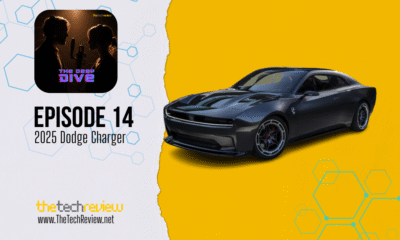Auto Tech
The 2025 Honda Prologue: A Deep Dive into Honda’s Electric Future
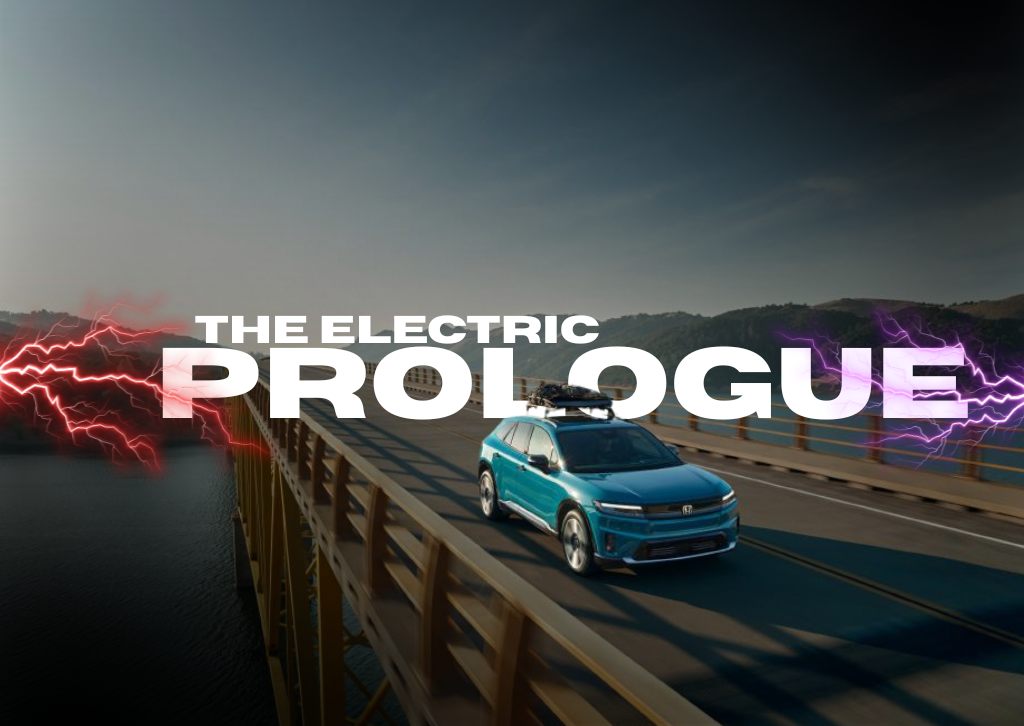
The 2025 Honda Prologue More Than Juse A New Name
Table of Contents
The electric vehicle revolution is in full swing, and after years of anticipation, Honda has firmly planted its flag in the mainstream electric SUV market with the 2025 Prologue. The name itself is a statement of intent, a prologue to a new chapter for a company long celebrated for its engineering prowess and reliability. But in a market already teeming with impressive competitors, does the Prologue have what it takes to stand out? We’re about to find out.
This in-depth review will explore every facet of the Honda Prologue, from its design and performance to its technology and practicality. We’ll also see how it stacks up against its key rivals in a side-by-side comparison, discuss who this electric SUV is best for, and answer some of the most frequently asked questions about Honda’s newest creation.
A Familiar Face with a New Heart: Design and Styling
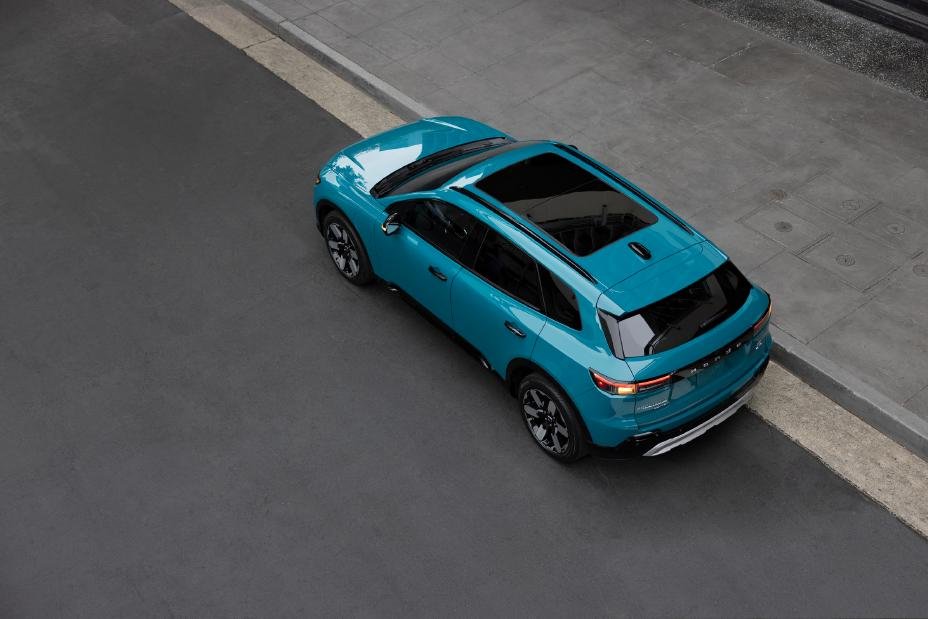
Honda has taken a refreshingly conservative approach to the Prologue’s design. In a world of futuristic and sometimes polarizing EV aesthetics, the Prologue looks… like a Honda. And for many, that’s a good thing. The “neo-rugged” design language translates to a clean, handsome, and substantial-looking SUV that wouldn’t look out of place next to a Passport or a CR-V.
The front end is clean and grille-less, as is typical for an EV, with a sleek black bar connecting the LED headlights. The side profile is long and low-slung, giving the Prologue a more wagon-like silhouette than some of its more upright competitors. The rear is adorned with a stylized “Honda” script in a modern font, a design choice that adds a touch of class.
The Prologue is a sizable vehicle, with a wheelbase that’s nearly identical to the Chevrolet Blazer EV, its platform-mate from General Motors. This long wheelbase contributes to a spacious interior, but more on that later. The overall length and width are also comparable to the Blazer EV, making the Prologue a true mid-size SUV.
Step Inside: A Spacious and Tech-Forward Cabin
The interior of the Prologue is where the collaboration with GM becomes most apparent. While the overall design is clean and uncluttered, with a horizontal layout that emphasizes space, those familiar with recent GM products will recognize the switchgear, steering wheel, and even the infotainment screen. This isn’t necessarily a bad thing, as the quality of the materials is generally good, and the layout is logical and user-friendly.
The centerpiece of the dashboard is an 11.3-inch touchscreen infotainment system that comes standard with Google Built-In. This means you get Google Maps, Google Assistant, and the Google Play Store integrated directly into the car’s system. For those who prefer to use their smartphones, wireless Apple CarPlay and Android Auto are also standard. The system is responsive, easy to navigate, and a significant step up from the infotainment systems found in some of Honda’s other models.
In front of the driver is an 11-inch digital instrument cluster that provides all the essential driving information in a clear and concise manner. The graphics are sharp, and the display is customizable to a certain degree.
Passenger space is a real highlight of the Prologue. The long wheelbase translates to generous legroom for both front and rear passengers. Headroom is also ample, even for taller individuals. The seats are comfortable and supportive, making the Prologue a great vehicle for long road trips.
Cargo space is also impressive. With the rear seats up, you get 25.2 cubic feet of space. Fold them down, and that expands to a cavernous 57.7 cubic feet. This makes the Prologue one of the more practical choices in its class, perfect for families or those who frequently haul bulky items.
Under the Skin: Performance, Battery, and Range
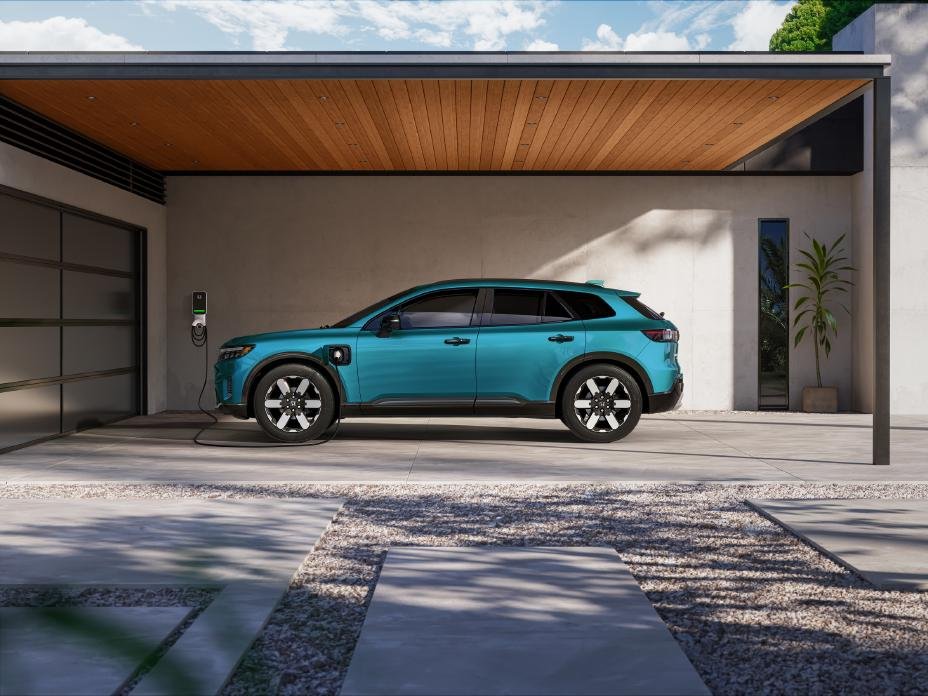
The Prologue is available in both single-motor front-wheel-drive (FWD) and dual-motor all-wheel-drive (AWD) configurations. The FWD model produces 220 horsepower and 236 lb-ft of torque, while the AWD model gets a significant bump to 300 horsepower and 333 lb-ft of torque.
While the Prologue isn’t going to win any drag races against a Tesla Model Y Performance, the acceleration is more than adequate for daily driving. The AWD model, in particular, feels peppy off the line and has plenty of power for merging onto the highway or passing slower traffic. The power delivery is smooth and linear, as you’d expect from an EV.
Where the Prologue really shines is in its ride comfort. Honda has tuned the suspension for a smooth and compliant ride, absorbing bumps and road imperfections with ease. The cabin is also exceptionally quiet, with minimal wind and road noise. This focus on comfort makes the Prologue a relaxing and enjoyable vehicle to drive, especially on long journeys.
All Prologue models are equipped with an 85.0-kWh battery pack. The EPA-estimated range varies depending on the drivetrain and trim level. The FWD models offer the most range, with an impressive 308 miles on a full charge. The AWD models see a slight reduction in range, with the EX and Touring trims rated at 294 miles and the top-of-the-line Elite trim rated at 283 miles.
When it comes to charging, the Prologue can accept up to 155 kW on a DC fast charger. This allows it to charge from 10% to 80% in about 35 minutes. While this isn’t the fastest charging speed in its class, it’s respectable and should be more than adequate for most users. For home charging, the Prologue comes with an 11.5-kW onboard charger that can fully charge the battery overnight.
Side-by-Side Comparison: The Prologue vs. The Competition
The electric SUV market is fiercely competitive, with a host of excellent options for buyers to choose from. Here’s how the Honda Prologue stacks up against some of its key rivals:
| Feature | Honda Prologue | Chevrolet Blazer EV | Ford Mustang Mach-E | Hyundai Ioniq 5 | Kia EV6 | Tesla Model Y |
|---|---|---|---|---|---|---|
| Starting MSRP | ~$47,400 | ~$50,195 | ~$43,495 | ~$41,800 | ~$42,600 | ~$44,990 |
| Drivetrain | FWD/AWD | FWD/RWD/AWD | RWD/AWD | RWD/AWD | RWD/AWD | RWD/AWD |
| Max Range | 308 miles | 324 miles | 312 miles | 303 miles | 310 miles | 320 miles |
| Max Horsepower | 300 hp | 557 hp | 480 hp | 320 hp | 576 hp | 456 hp |
| Cargo Space | 57.7 cu ft | 59.1 cu ft | 59.7 cu ft | 59.3 cu ft | 50.2 cu ft | 76.0 cu ft |
| 0-60 mph | ~5.9 sec (AWD) | ~4.0 sec (SS) | ~3.5 sec (GT) | ~5.1 sec (AWD) | ~3.4 sec (GT) | ~3.5 sec (Perf) |
As you can see from the table, the Prologue is competitively priced and offers a good amount of range and cargo space. However, it falls short of its rivals in terms of outright performance. The Blazer EV, Mustang Mach-E, EV6, and Model Y all offer high-performance variants that are significantly quicker than the Prologue.
The Ioniq 5 and EV6 also have an advantage in charging speed, thanks to their 800-volt architecture that allows for charging speeds of up to 350 kW. This means they can charge from 10% to 80% in as little as 18 minutes, which is a significant advantage for those who frequently take long road trips.
Who Is the Honda Prologue Best For?
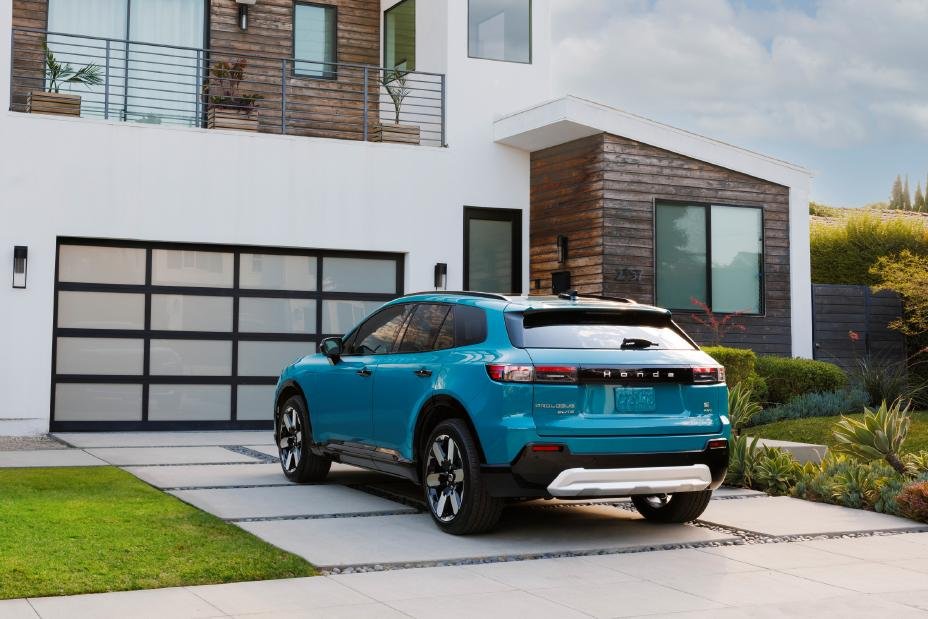
The Honda Prologue is not trying to be the sportiest or the fastest electric SUV on the market. Instead, it focuses on the traditional Honda values of comfort, practicality, and reliability. This makes it an excellent choice for a few key demographics:
- Existing Honda Owners: For the millions of loyal Honda owners who are looking to make the switch to an EV, the Prologue is the perfect vehicle. It offers a familiar driving experience and a user-friendly interface that will make the transition from a gas-powered Honda seamless.
- Families: With its spacious interior, generous cargo capacity, and comfortable ride, the Prologue is an ideal family vehicle. It has plenty of room for kids, car seats, and all the gear that comes with them.
- Commuters: For those with a daily commute, the Prologue’s long range and comfortable ride make it an excellent choice. The quiet cabin and smooth power delivery will make even the most stressful commute a little more relaxing.
- Value-Conscious Buyers: While the Prologue isn’t the cheapest EV on the market, it offers a lot of value for the money. It comes well-equipped with standard features, and its long range and low running costs will save you money in the long run.
Pricing and Trims
The 2025 Honda Prologue is available in three trim levels: EX, Touring, and Elite. Here’s a breakdown of what each trim includes (prices exclude tax, license, registration, and a $1,450 destination charge):
- EX: The base EX trim starts at $47,400 for the FWD model. It comes standard with 19-inch alloy wheels, heated front seats, a 10-way power-adjustable driver’s seat, dual-zone automatic climate control, the 11.3-inch touchscreen with Google Built-In, and the Honda Sensing suite of driver-assist features.
- Touring: The mid-range Touring trim starts at $51,700 for the FWD model. It adds leather-trimmed seats, a leather-wrapped steering wheel, a Bose premium audio system, front and rear parking sensors, and an auto-dimming rearview mirror.
- Elite: The top-of-the-line Elite trim comes standard with AWD and starts at $57,900. It adds 21-inch alloy wheels, ventilated front seats, a heated steering wheel, a head-up display, and a 110-volt power outlet.
Q&A: Answering Your Burning Questions
Q: Is the Honda Prologue eligible for the federal EV tax credit?
A: Yes, the Honda Prologue is assembled in North America and meets the battery sourcing requirements to be eligible for the full $7,500 federal EV tax credit. However, there are income limitations for buyers, so be sure to check with a tax professional to see if you qualify.
Q: What is the warranty on the Honda Prologue’s battery?
A: The Prologue’s battery is covered by an 8-year/100,000-mile warranty, which is the industry standard for EVs.
Q: How does the partnership with GM affect the Prologue?
A: The Prologue is built on GM’s Ultium platform, which is also used for the Chevrolet Blazer EV, Cadillac Lyriq, and other GM EVs. This means that the Prologue shares its battery, motors, and other key components with these vehicles. However, Honda has tuned the suspension and handling to give the Prologue a unique driving experience.
Q: Can the Prologue tow a trailer?
A: Yes, the Prologue has a towing capacity of up to 1,500 pounds, which is enough for a small trailer or a pair of jet skis.
The Verdict: A Solid First Effort with Room for Improvement
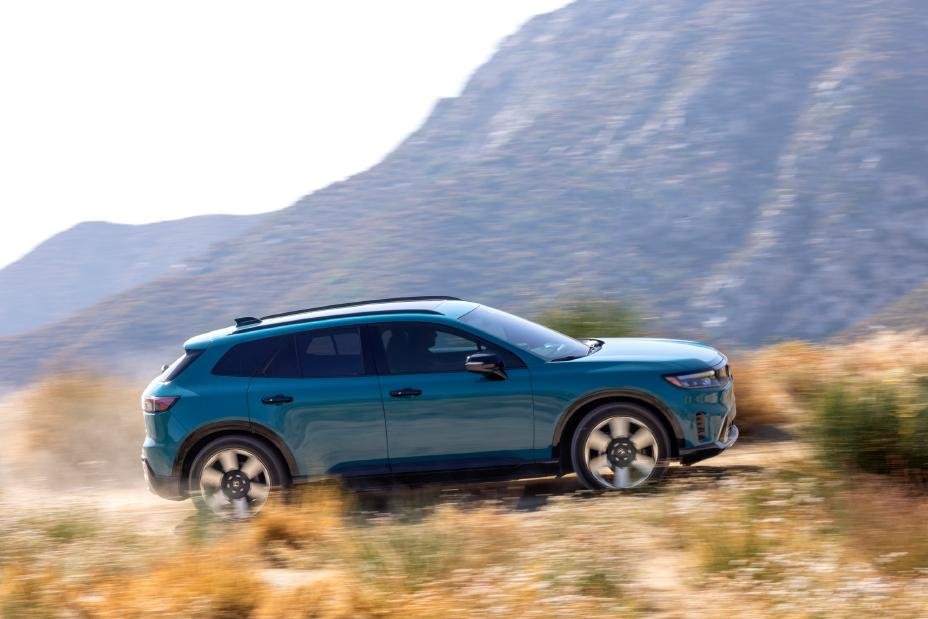
The 2025 Honda Prologue is a commendable entry into the mainstream electric SUV market for Honda. It’s a spacious, comfortable, and practical vehicle that will appeal to a wide range of buyers, especially those who are already familiar with the Honda brand. The long range, user-friendly tech, and competitive pricing make it a compelling choice in a crowded segment.
However, the Prologue is not without its flaws. The performance is adequate but uninspired, and the charging speed is slower than some of its key rivals. The interior, while functional, lacks the premium feel of some competitors, and the reliance on GM parts may be a turn-off for some Honda purists.
Ultimately, the Prologue is a solid, well-rounded electric SUV that gets a lot of things right. It may not be the most exciting or the most technologically advanced EV on the market, but it’s a vehicle that you can count on to be a reliable and practical daily driver. And for many buyers, that’s exactly what they’re looking for. The Prologue is a strong foundation for Honda’s electric future, and we’re excited to see what they come up with next.
Auto Tech
The 2025 Volkswagen ID. Buzz: The Electric Minivan That Brings Back the Counterculture Icon
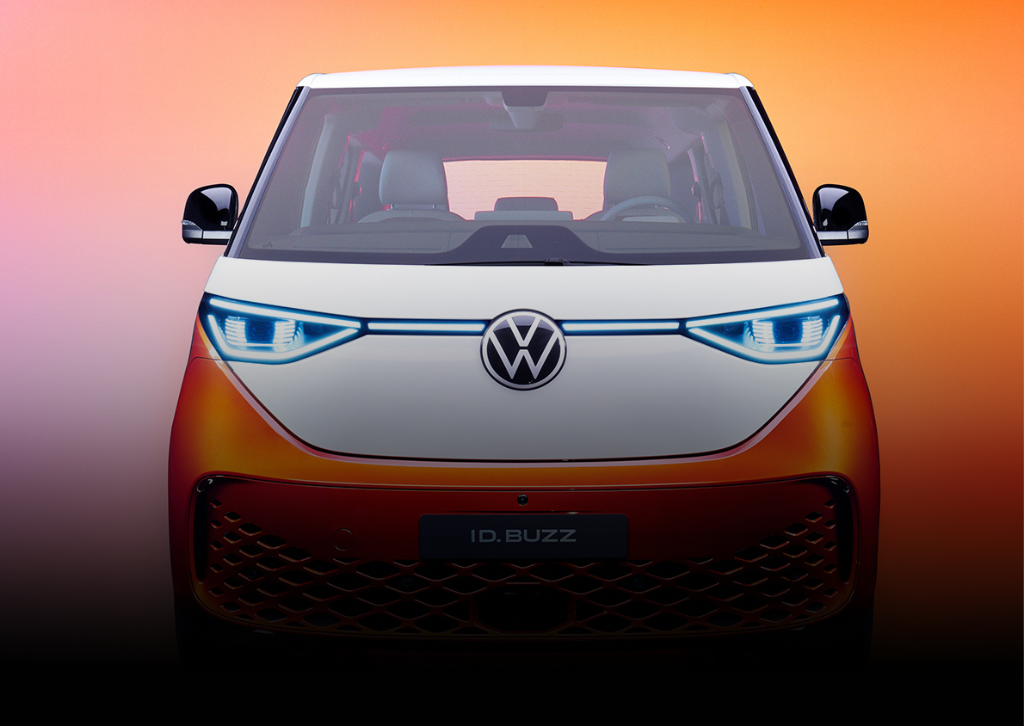
After years of anticipation and nostalgic teasing, Volkswagen has finally delivered on its promise to resurrect one of automotive history’s most beloved icons. The 2025 ID. Buzz isn’t just another electric vehicle joining an increasingly crowded market—it’s a bold reimagining of the classic VW Microbus for the modern era, blending retro charm with cutting-edge electric technology.
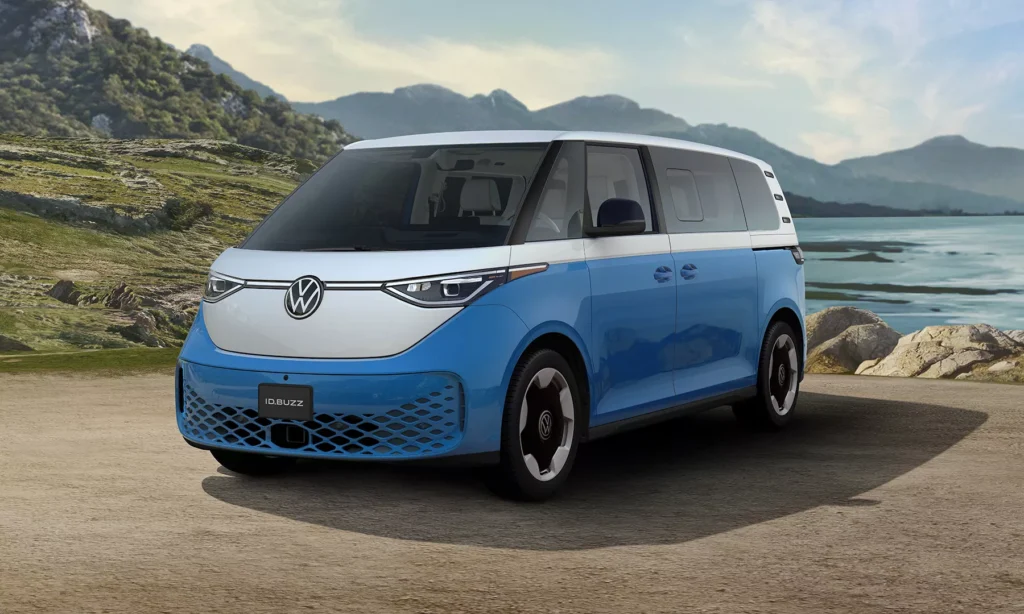
A Design That Turns Heads
The ID. Buzz makes no attempt to hide its heritage. From the moment you see it, the two-tone paint scheme, short overhangs, and upright stance immediately evoke memories of the original 1960s Type 2 bus that became synonymous with surf culture, road trips, and freedom. But this is no simple retro pastiche. Volkswagen has created something that feels both familiar and thoroughly contemporary, with smooth surfaces, flush-mounted handles, and LED lighting that give it a distinctly futuristic character.
The front fascia features a illuminated VW logo and distinctive V-shaped light bar that’s become a signature of the ID. family. Available in a palette of vibrant colors—some with contrasting roofs—the ID. Buzz has the kind of visual presence that makes people smile when they see it on the road.
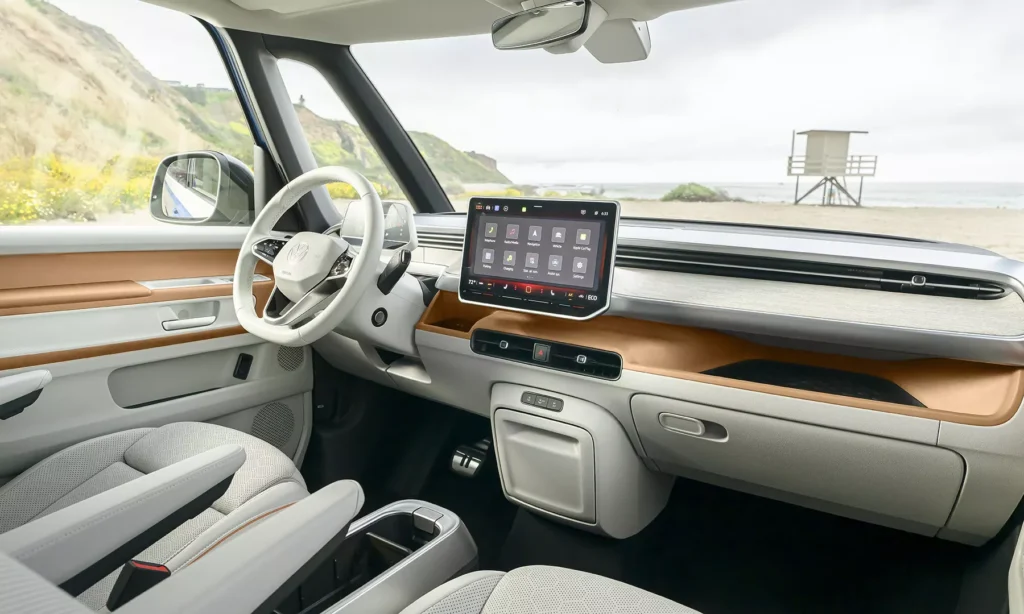
Two Configurations for Different Needs
Volkswagen offers the ID. Buzz in two distinct wheelbases. The standard version comes with two rows of seating and accommodates five passengers, while the long-wheelbase variant adds a third row for seven-passenger capacity. This flexibility allows buyers to choose between maximizing cargo space or passenger capacity depending on their lifestyle needs.
The interior is remarkably spacious, thanks to the skateboard-style electric platform that eliminates the need for a transmission tunnel and allows the wheels to be pushed to the corners. This creates an airy, lounge-like atmosphere that harks back to the original Microbus’s reputation for generous interior volume. The dashboard is clean and minimalist, dominated by a large touchscreen infotainment system and a smaller digital instrument cluster.
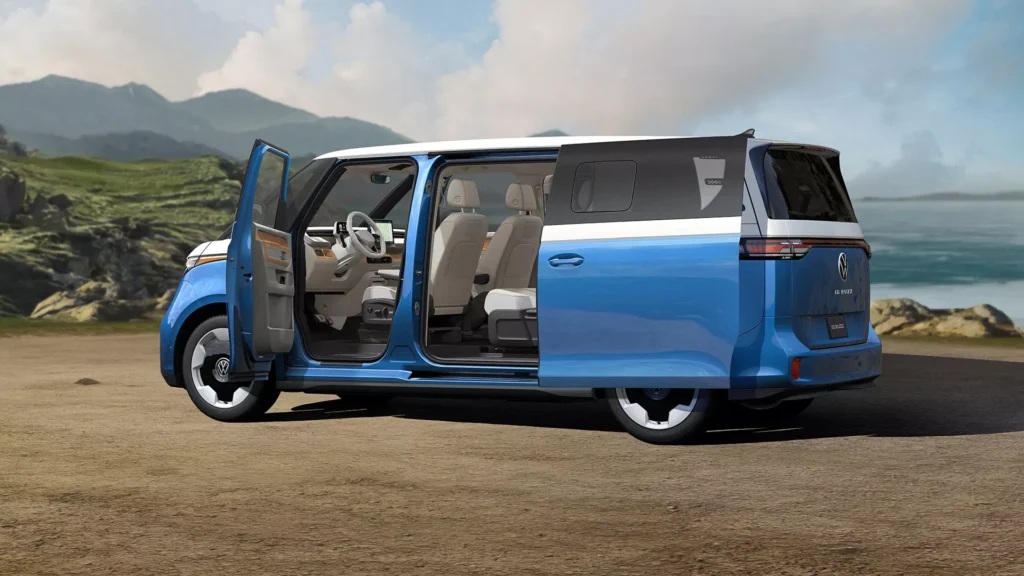
Electric Performance and Range
Under the floor sits a 91 kWh battery pack that powers a rear-mounted electric motor producing 282 horsepower. This setup provides brisk acceleration that belies the ID. Buzz’s substantial size—it can sprint from 0-60 mph in around 6 seconds. All-wheel drive versions add a front motor for enhanced traction and performance.
Range is estimated at approximately 230-260 miles depending on configuration and driving conditions, which is competitive for a vehicle of this size and should prove adequate for most family duties and daily driving. The ID. Buzz supports DC fast charging at rates up to 170 kW, allowing for 10-80% charges in roughly 30 minutes at compatible charging stations.
Technology and Features
Inside, the ID. Buzz comes loaded with modern amenities. The infotainment system features wireless Apple CarPlay and Android Auto, navigation, and voice controls. Available features include a panoramic glass roof, premium sound system, and a full suite of driver assistance technologies including adaptive cruise control, lane-keeping assist, and automated emergency braking.
The rear doors feature a power sliding mechanism, making entry and exit easier in tight parking spaces—a practical touch for families. The cargo area is generous, and with the rear seats folded, the ID. Buzz can swallow impressive amounts of gear, making it genuinely versatile for everything from camping trips to home improvement store runs.
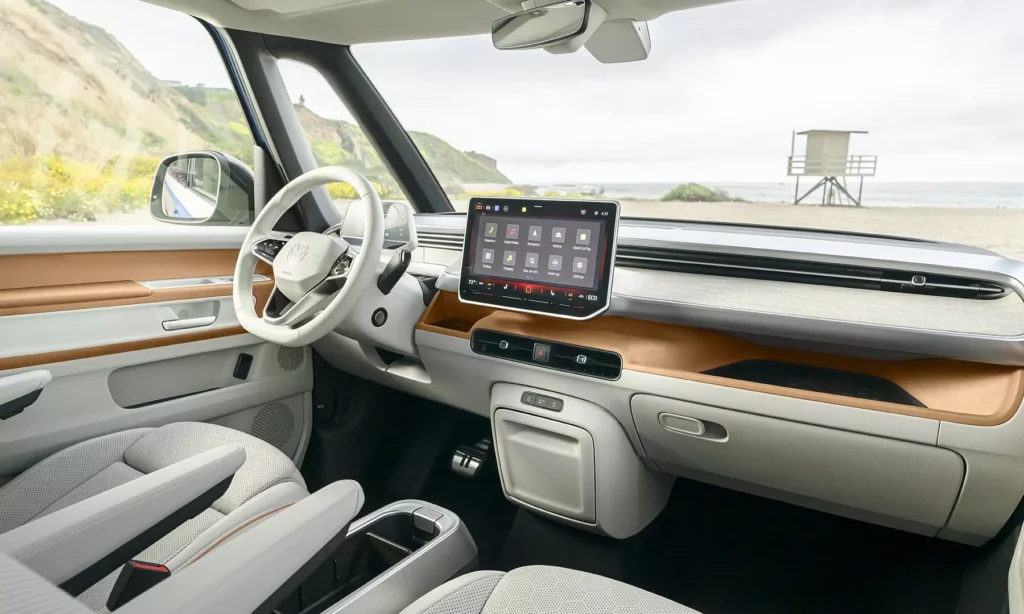
The Verdict
The 2025 Volkswagen ID. Buzz represents something increasingly rare in today’s automotive landscape: a vehicle with genuine personality. In a market dominated by anonymous crossovers and look-alike SUVs, the ID. Buzz dares to be different, fun, and emotionally engaging.
It won’t be the cheapest electric vehicle option, with pricing starting in the mid-$60,000 range, but it offers something most competitors don’t—a sense of joy and nostalgia wrapped in practical, modern packaging. For families seeking an electric vehicle that doesn’t compromise on space or style, or for anyone who’s ever dreamed of owning a classic VW bus but wants modern reliability and zero emissions, the ID. Buzz delivers on its promise.
Volkswagen has managed to bottle lightning twice, creating a modern classic that honors its heritage while moving boldly into an electric future. The ID. Buzz proves that going electric doesn’t mean sacrificing character—sometimes it means amplifying it.

The best EV Reviews are here on www.thetechreview.net
Auto Tech
The Electric Revolution Is Here: An In-Depth Review of the 2025 Chevrolet Silverado EV
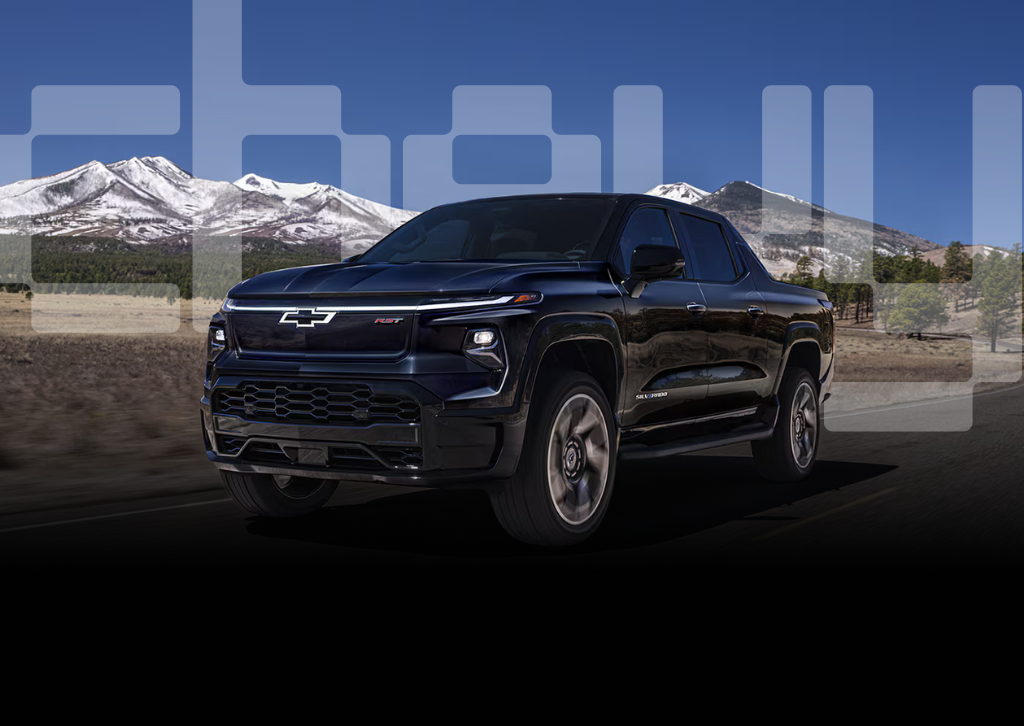
2025 Chevrolet Silverado EV
It’s no secret that the future of the automotive industry is electric, but for the longest time, the pickup truck segment seemed to be the last frontier to be fully conquered. That’s all changed, and no one is taking the electric truck game more seriously than Chevrolet. We had the opportunity to spend a week with the 2025 Chevrolet Silverado EV—specifically, the LT Extended Range model—and it’s clear that this isn’t just an electrified Silverado; it’s a new kind of vehicle designed to be a leader in its class. From its impressive performance to its innovative cabin and surprising versatility, this truck is ready to challenge perceptions and win over the hearts of truck enthusiasts and EV newcomers alike.
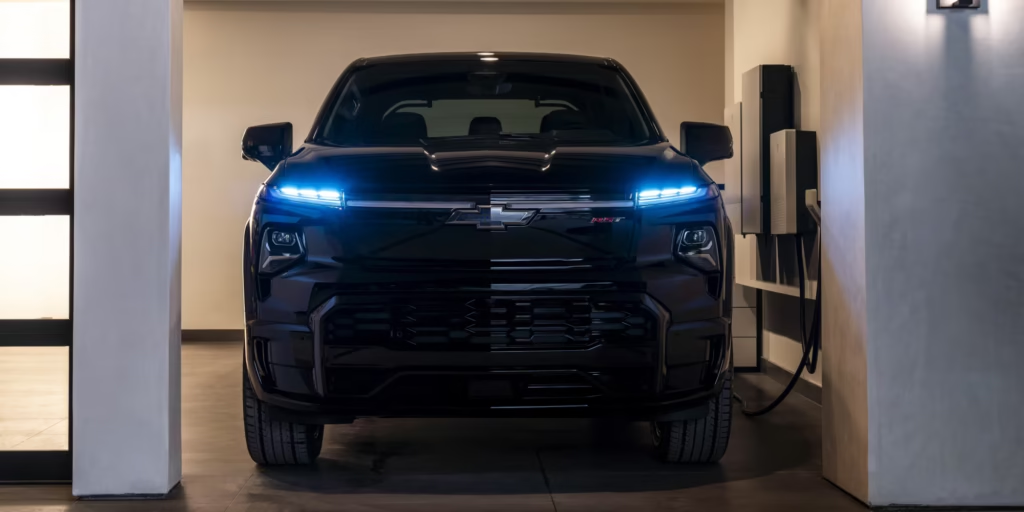
The Test Drive: A Big Truck with Nimble Moves
The moment you get behind the wheel of the Silverado EV, its size is immediately apparent. This is a big, heavy truck, with a curb weight approaching 8,500 pounds in our test model. But what’s truly remarkable is how well it hides that heft. Thanks to its standard all-wheel drive and available four-wheel steering, the Silverado EV handles with a surprising agility for a vehicle of its size. The rear-wheel steering, a feature we found universally acclaimed in GM’s large EV trucks, makes maneuvering in tight parking lots and navigating city streets far more manageable. While we wouldn’t call it “nimble,” it’s certainly more graceful than its physical dimensions would suggest.
The acceleration is, in a word, phenomenal. In its default drive mode, the power is more than sufficient for everyday driving. But engage the “Wide Open Watts” (WOW) mode, and this behemoth transforms into a sports car-like sprinter, hitting 0 to 60 mph in a blistering 4.2 seconds. This instant torque is not just for fun; it makes merging onto highways and overtaking traffic a breeze.
Chevy’s regenerative braking is also one of the best in the business. The system is smooth, intuitive, and seamlessly blends with the friction brakes, making one-pedal driving not only possible but enjoyable. We managed to bring the truck to a stop from 70 mph in just 196 feet, which is impressive given its monumental mass.
Inside the Cabin: A Connected and Comfortable Command Center
Stepping inside the Silverado EV, you’re greeted by a cabin that feels both familiar and futuristic. The LT model we drove provided a significant upgrade from the work-truck trims, featuring power-adjustable, heated, and ventilated front seats, heated rear seats, and a seven-speaker Bose stereo. The overall feel is one of comfort and spaciousness, with plenty of room for both front and rear passengers to stretch out.
The centerpiece of the interior is the massive, reconfigurable dashboard. The LT trim features a huge 17.7-inch infotainment touchscreen paired with a large 11.0-inch driver information display. The Google-based infotainment system is intuitive and responsive, seamlessly integrating with Google Maps for navigation and Google Assistant for voice commands. It’s a fantastic system, but one notable drawback is that only the smaller infotainment screen units come with Apple CarPlay and Android Auto compatibility, forcing you to rely on the native Google navigation on the larger screens.
One of our favorite design choices is the column-mounted shifter, which opens up a cavernous storage bin between the dashboard and the center armrest, a very practical touch. The lockable, weatherproof eTrunk in the front is also a fantastic addition, offering a secure space for cargo with a 120-volt outlet for powering tools or devices.
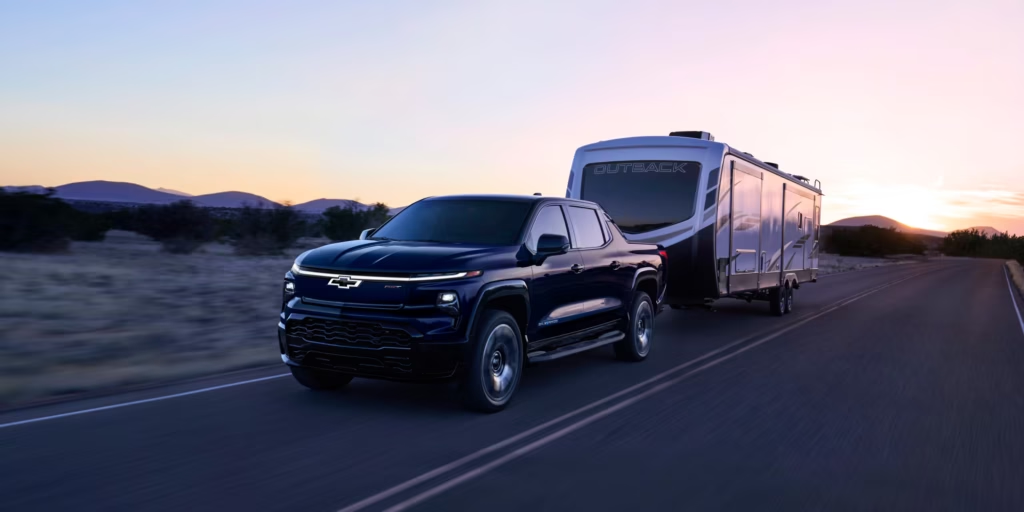
Specifications: Range, Charging, and Performance
The Silverado EV offers a variety of configurations, with a range of up to 492 miles on the Max Range battery in the Work Truck trim. Our Extended Range LT model had an EPA-estimated range of 408 miles, though our real-world 75-mph highway test saw a range closer to 310 miles. It’s important to note that these figures can vary greatly with driving style, load, and terrain.
Recharging is a key concern for any EV owner, and the Silverado EV’s Ultium platform handles it well. It supports DC fast charging up to 350 kW, allowing you to add a GM-estimated 100 miles of range in just 10 minutes at a compatible public fast-charging station. On a Level 2 home charger, a full charge from near empty could take around eight to ten hours, making it perfect for overnight charging.
Here are the key specs for the 2025 Silverado EV:
- Horsepower (RST): Up to 754 hp
- Torque (RST): Up to 785 lb-ft
- 0-60 mph (RST/WT): 4.1 seconds (WOW mode) / 5.4 seconds
- Max Towing Capacity: 12,500 lbs
- Payload Capacity: 1,800 lbs
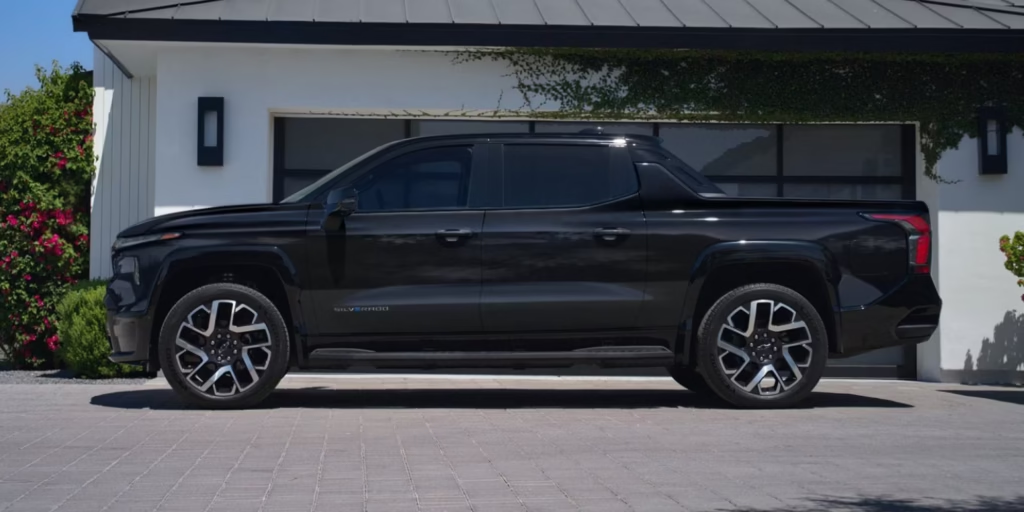
Ride Quality and Practicality
The Silverado EV’s ride quality is a mixed bag. While it’s certainly comfortable on smooth surfaces, we did notice more pitch and head toss than we would have expected, a possible side effect of its sheer weight and suspension tuning. However, the available Adaptive Air Ride Suspension (on the RST model) does an excellent job of smoothing out rough roads and can adjust the ride height for better aerodynamics or ground clearance.
In terms of practicality, the Silverado EV shines. The innovative Multi-Flex Midgate allows you to extend the bed into the cabin by folding down the rear seats, increasing the total load floor length from 5’11” to an impressive 10’10”. The Multi-Flex Tailgate offers six different configurations, making it easier than ever to load, unload, and secure cargo. It’s clear that Chevrolet paid close attention to the real-world needs of truck owners when designing this vehicle.
Pros and Cons
| Pros | Cons |
|---|---|
| Instant Torque & Acceleration: Incredibly quick for a truck of its size. | Highway Range: Real-world highway range may be lower than EPA estimates. |
| Massive Infotainment System: Large, responsive, and Google-integrated. | Limited Smartphone Integration: No Apple CarPlay or Android Auto with the large screen. |
| Innovative Midgate & Tailgate: Adds incredible versatility for hauling. | Ride Quality: Can feel bouncy or harsh at times without the adaptive air suspension. |
| Fast Charging: Adds 100 miles of range in just 10 minutes. | Efficiency: Very heavy and thus less efficient than smaller EVs. |
| Super Cruise: The best hands-free driving system on the market. | Cost: Starting price is higher than many comparable gas-powered trucks. |
Competition Comparison
| Feature | 2025 Chevrolet Silverado EV | 2025 Ford F-150 Lightning | 2025 Rivian R1T |
|---|---|---|---|
| Base Range (Est.) | 282 – 492 miles | 240 – 320 miles | 270 – 420 miles |
| Max Horsepower | 754 hp | 580 hp | 1,025 hp |
| Towing Capacity | Up to 12,500 lbs | Up to 10,000 lbs | Up to 11,000 lbs |
| 0-60 mph | 4.1 sec (WOW) | ~4.0 sec (Extended Range) | 3.0 sec (Quad-Motor) |
| Unique Features | Multi-Flex Midgate, eTrunk | Mega Power Frunk, Pro Power Onboard | Gear Tunnel, Tank Turn (future), Quad-Motor |
| Tech Integration | Google Built-in | SYNC 4A (with CarPlay/AA) | In-house system (no CarPlay/AA) |
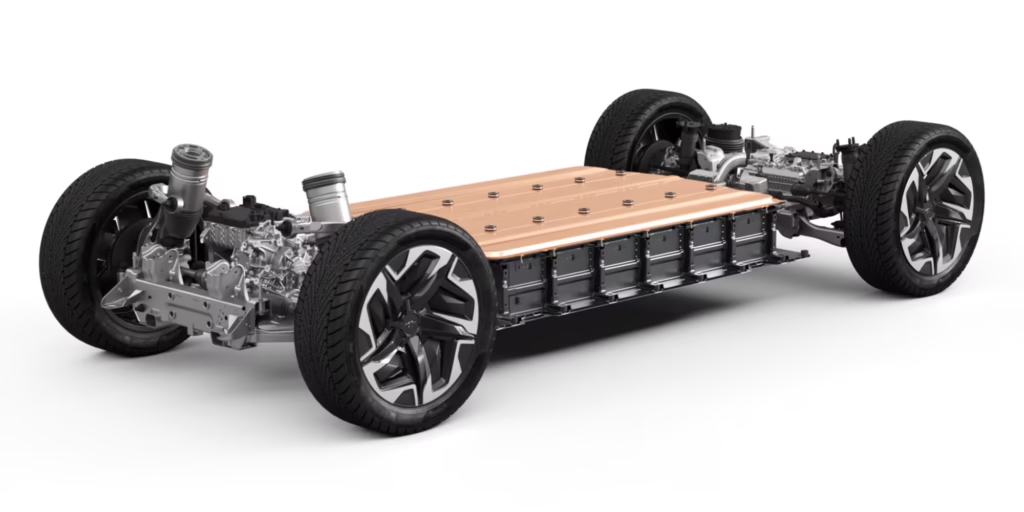
Q&A: Your Top Questions Answered
- How does the Silverado EV perform off-road? The Silverado EV’s all-wheel drive and available adaptive air suspension make it highly capable for light to moderate off-roading. Its sheer size and weight, however, can be a limiting factor in more challenging terrain.
- Is the Silverado EV a unibody or body-on-frame? The Silverado EV is built on GM’s Ultium platform, which is an all-electric, dedicated chassis. It is not a unibody like some competitors, but a body-on-frame design, similar to its gas-powered counterparts. This gives it the robust, heavy-duty feel that traditional truck buyers expect.
- Can the Silverado EV power my home or tools? Yes, with the optional PowerBase off-board power accessory, the Silverado EV can deliver up to 10.2 kW of power through its various outlets, making it a powerful generator for a campsite, a job site, or even your home during a power outage.
- Is the Silverado EV available with a traditional bed? Yes, the standard bed length is 5’11”, which is a typical size for a crew cab truck. The real innovation lies in the Multi-Flex Midgate, which allows you to extend the bed’s length for carrying longer items while still keeping the tailgate closed.
- How does the Silverado EV handle in cold weather? Like all EVs, the Silverado EV will see a reduction in range in very cold temperatures due to the impact on battery efficiency and the energy required for cabin heating. However, its advanced battery management system and robust Ultium platform are designed to mitigate these effects.
- Are there any known quality control issues? While the Silverado EV is still a relatively new model, some early reviews and consumer feedback have mentioned issues with camera quality and potential water leaks around the windshield. It’s always a good idea to check specific owner forums and reviews for long-term reliability.
- Can I tow with it? How does that affect range? The Silverado EV has an impressive max towing capacity of 12,500 pounds. However, towing will significantly impact the vehicle’s range. Expect a range reduction of around 50% or more when towing a heavy load, especially at highway speeds.
- What are the different trim levels available? For 2025, the Silverado EV lineup has expanded to include the base Work Truck (WT), the mid-range LT, and the top-of-the-line RST. The trims offer different battery sizes and feature sets, with the LT and RST providing more comfort and technology.

The best selection of EV car reviews here at www.TheTechReview.net
Auto Tech
Vanderhall Electrifies the Open Road: Introducing the All-Electric SantaRosa
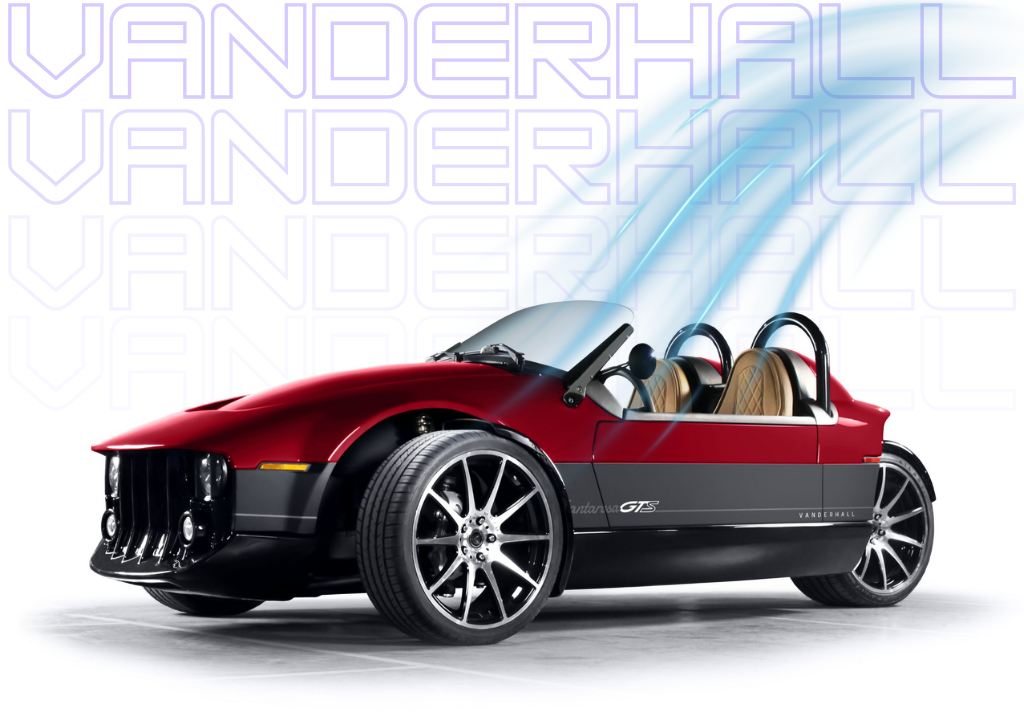
Vanderhall Santarosa
For years, Vanderhall has carved a unique niche in the automotive world, offering an exhilarating, open-air driving experience unlike any other. Known for their distinctive three-wheeled autocycle designs, these American-made machines have captivated enthusiasts with their blend of classic roadster aesthetics and modern performance. Until now, that performance has been powered by internal combustion engines, but a new era is dawning. Vanderhall is officially embracing the electric revolution with the highly anticipated, all-electric SantaRosa.
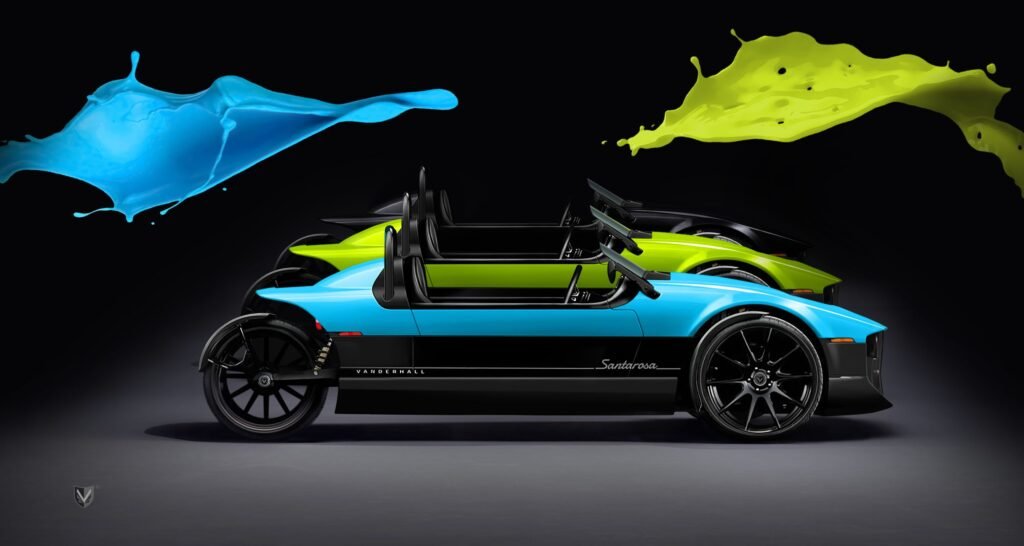
A Legacy of Gasoline-Powered Thrills
Vanderhall’s journey began with models like the Laguna, Venice, and Carmel, each a testament to the brand’s commitment to raw driving pleasure. These early iterations, often powered by turbocharged gasoline engines sourced from General Motors, delivered impressive acceleration and agile handling. The characteristic roar of the engine, the wind in your hair, and the direct connection to the road were hallmarks of the Vanderhall experience. Owners reveled in the blend of sportiness and retro charm, making these gas-powered autocycles beloved for weekend cruises and spirited drives alike.
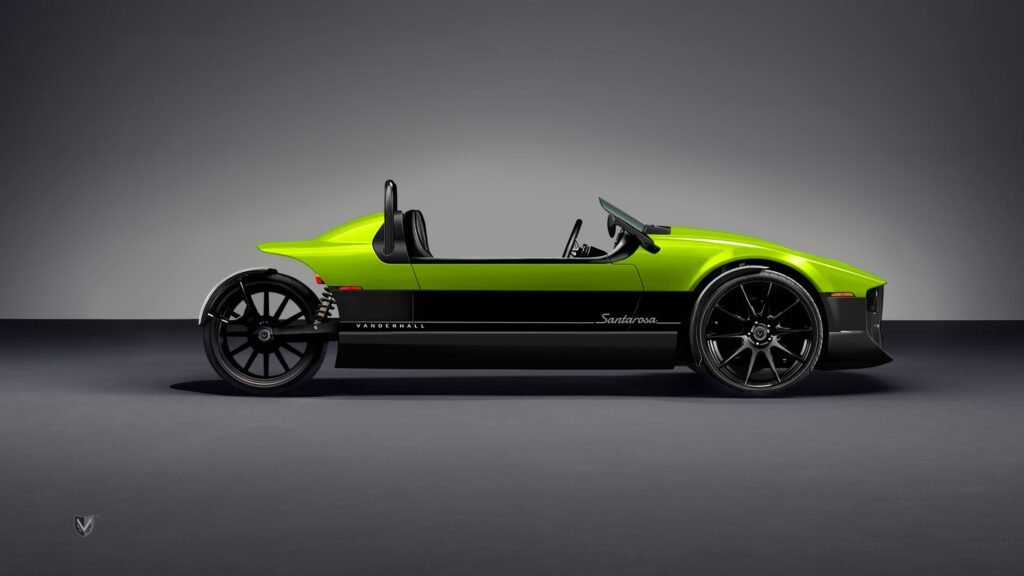
The Silent Revolution: Vanderhall Goes Electric
The introduction of the SantaRosa marks a pivotal moment for Vanderhall. This move to an all-electric powertrain signals not only a commitment to sustainability but also a bold step into the future of performance driving. The silence of electric propulsion will undoubtedly transform the driving experience, offering a new kind of thrill – one characterized by instant torque and a whisper-quiet ride, all while retaining the iconic open-cockpit design.
The SantaRosa: A Glimpse into the Future
While official images and full specifications are still emerging, early glimpses and reliable sources suggest the SantaRosa will be a groundbreaking addition to the Vanderhall lineup. We can expect it to retain the brand’s signature aesthetic – low-slung, aerodynamic, and undeniably eye-catching
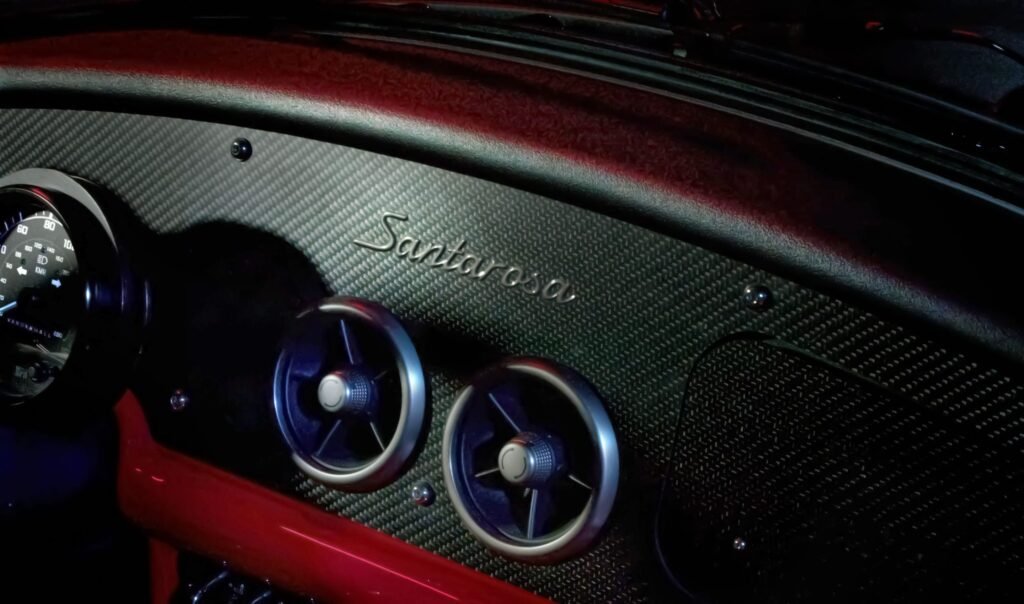
Anticipated Specs and Features:
- Electric Powertrain: The heart of the SantaRosa will be its electric motor, promising exhilarating acceleration characteristic of EVs. While specific power output figures are yet to be fully confirmed, expect performance that lives up to Vanderhall’s sporty reputation.
- Top Speed: Early indications suggest a top speed in the range of 100-110 mph (160-177 km/h), providing plenty of excitement on the open road.
- Range: One of the most critical aspects of any EV is its range. The SantaRosa is rumored to offer a substantial driving range, potentially upwards of 200 miles (320 kilometers) on a full charge. This would make it suitable for longer cruises and day trips without range anxiety.
- Battery Technology: Vanderhall is expected to utilize advanced battery technology to ensure both optimal performance and efficient charging.
- Modern Amenities: While retaining its minimalist, driver-focused ethos, the SantaRosa will likely incorporate modern conveniences. This could include a digital display for essential information, possibly a touchscreen infotainment system, and connectivity features. Regenerative braking will almost certainly be a standard feature, helping to extend the range.
- Charging: The SantaRosa will support various charging methods, likely including Level 2 home charging and DC fast charging capabilities for quicker top-ups on the go.
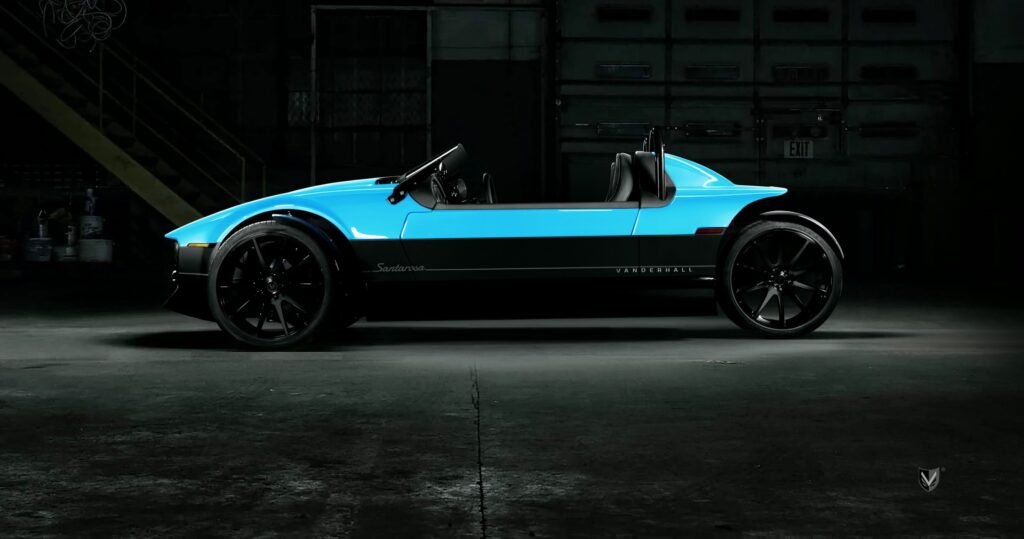
Availability
As of now, the Vanderhall SantaRosa is expected to become available to the public in late 2024 or early 2025. Vanderhall typically operates with a direct-to-consumer model and a network of authorized dealers, so potential buyers should keep an eye on official announcements for pre-order information and precise launch dates.
The Road Ahead
The all-electric SantaRosa represents a bold new chapter for Vanderhall. It blends the brand’s cherished open-air driving philosophy with the cutting-edge technology of electric propulsion. As the automotive world rapidly shifts towards electrification, Vanderhall is proving that the joy of driving, the connection to the road, and the thrill of unique design can thrive in a silent, emission-free future. The SantaRosa is poised to redefine what an electric autocycle can be, offering an electrifying and unforgettable experience to a new generation of enthusiasts.

If electric cars is your thing then click to read all our electric car reviews
-

 Photography3 months ago
Photography3 months agoSony FE 16mm f/1.8 G Review: The Ultra-Wide Prime for the Modern Creator
-

 Computers3 months ago
Computers3 months agoAsus ProArt Display 6K PA32QCV Review: A Visual Feast for Professionals
-

 Tablets5 months ago
Tablets5 months agoClash of the Titans: 13″ iPad Pro M4 vs. Samsung Galaxy Tab S10 Ultra – Which Premium Tablet Reigns Supreme?
-

 Home Tech3 months ago
Home Tech3 months agoThe Guardian of Your Threshold: An In-Depth Review of the Google Nest Doorbell
-

 Computers4 months ago
Computers4 months agoASUS Zenbook Duo: A Pretty Awesome Dual-Screen Laptop
-

 Photography4 months ago
Photography4 months agoAdobe’s “Project Indigo” is the iPhone Camera App We’ve Been Waiting For, and It’s Awesome
-

 Photography3 months ago
Photography3 months agoDJI Osmo 360 go: The Next Generation of Immersive Storytelling?
-

 Health Tech3 months ago
Health Tech3 months agoLumen Metabolism Tracker: A Deep Dive into Your Metabolic Health
-

 Computers4 months ago
Computers4 months agoApple Mac Studio Review: A Desktop Powerhouse Redefined
-

 Home Tech3 months ago
Home Tech3 months agoRevolution R180 Connect Plus Smart Toaster: More Than Just Toast?
-

 Computers4 months ago
Computers4 months agoSamsung 15.6” Galaxy Book5 360 Copilot AI Laptop: A Deep Dive into the Future of Productivity
-

 Buying Guides4 months ago
Buying Guides4 months agoThe Ultimate Workout Soundtrack: The Best Wireless Headphones for Your Fitness Journey









